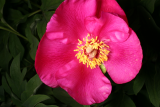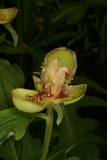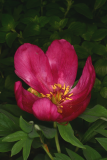Additional notes (click to expand)
Commemorative
The glorious peony, commemorates Paeon, physician to the gods of ancient Greece, who enjoyed the best private practice of the era. Homer’s Iliad v. 401 and 899 (c. 800 BC) provides further details (Murray, 1924). The name Paeon came to be associated as being Apollo, Greek god of healing, poetry, the sun and much else, and father of Aesculapius/Asclepias. Hesiod, the greatest Greek author after Homer, about a century later, clearly regarded them as separate deities, viz:
If neither Phoebus Apollo does save us from death, nor Paean who knows remedies for everything.
The Mycenaean Greeks of the late Bronze Age (1600–1100 BC) worshipped a god of healing called Paiawon, ‘a divinity with a formidable knowledge of herbs and drugs ...’ (Graf, 2009), and Apollo was not known. Paiawon’s cult disappeared after the collapse of the Mycenaean world. The fusion of Paiawon/Paeon and Apollo occurred much later as both being names for the god of healing.
Theophrastus (c. 300 BC), repeated by Pliny (AD 79), wrote that if a woodpecker saw one
collecting peony seed during the day, it would peck out one’s eyes, and (like mandrake) the roots had to be pulled up at night by tying them to the tail of a dog, with the added warning that one’s ‘fundament might fall out’ (anal prolapse) if one cut the roots with a knife. Theophrastus, I am glad to say, thought this ‘far-fetched’, as did Pliny, viz: ‘all this, however, I take to be so much fiction, most frivolously invented to puff up their supposed marvellous properties’.
Oakeley, Dr. Henry. (2012). Doctors in the Medicinal Garden. Plants named after physicians. Royal College of Physicians.
link
Medicinal
Paeonia mascula (L.)Mill. ssp arietina The Balkan or Male (from mascula) peony. Distribution: China, Middle East, southern Europe and Morocco. The peony commemorates Paeon physician to the Gods of ancient Greece (Homer’s Iliad v. 401 and 899, circa 800 BC). Paeon, came to be associated as being Apollo, Greek god of healing, poetry, the sun and much else, and father of Aesculapius/Asclepias. Theophrastus (circa 300 BC), repeated by Pliny, wrote that if a woodpecker saw one collecting peony seed during the day, it would peck out one’s eyes, and (like mandrake) the roots had to be pulled up at night by tying them to the tail of a dog, and one’s ‘fundament might fall out’ [anal prolapse] if one cut the roots with a knife. Theophrastus commented ‘all this, however, I take to be so much fiction, most frivolously invented to puff up their supposed marvellous properties’. The roots, hung round the neck, were regarded as a cure for epilepsy for nearly two thousand years, and while Galen would have used P. officinalis, Parkinson (1640) recommends the male (i.e. mascula) peony for this. He also recommends drinking a decoction of the roots. Elizabeth Blackwell’s A Curious Herbal (1737), published by the College of Physicians, explains that it was used to cure febrile fits in children, associated with teething. Although she does not mention it, these stop whatever one does. Parkinson also reports that the seeds are used for snake bite, uterine bleeding, people who have lost the power of speech, nightmares and melancholy.
Oakeley, Dr. Henry F. (2013). Wellcome Library notes.
link
Nomenclature
Synonym of Paeonia arietina
Plants of the World online, Kew Science https://powo.science.kew.org/taxon/urn:lsid:ipni.org:names:711740-1
link
Podcast
Paeonia mascula subsp. arietina
Family: PAEONIACEAEGenus: Paeonia
Species: mascula
SubSpecies: arietina
Common names: Ram's Horn Paeony
Distribution summary: N. Africa, Eurasia
Habit: Perennial
Hardiness: H6 - Hardy; very cold winter
Garden status: Not currently grown
Flowering months: May
Reason for growing: Commemorative, medicinal




.JPG)

.JPG)



